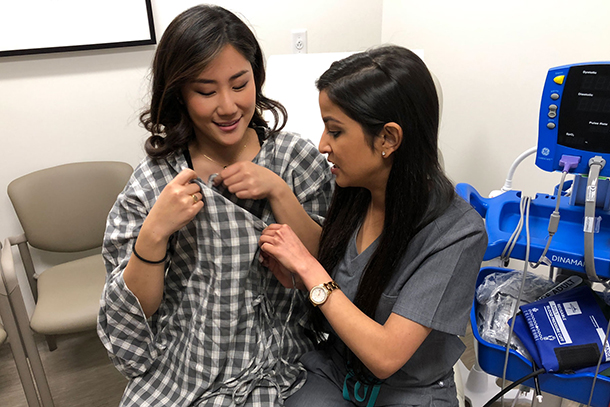If you’ve had to stay in a hospital, you’ve probably struggled with the straps and tried to close the gaps on your hospital gown. The traditional gown can leave a patient shivering and feeling exposed.
Sona Shah and Uni Choe, medical students in their third year at the Keck School of Medicine of USC, have come up with something better — chic hospital clothes that are, in Choe’s words, “interesting, fun and couture-related.”
“We created something comfortable and practical,” Choe said, “but more than anything it’s about patient empowerment.”
The pair researched materials and worked with a fashion designer to create a two-piece garment that covers from head to toe and makes care easier for patients and physicians. A soft, flowing smock with access ports for exams is combined with pants that resemble pajama bottoms.
“In the hospital, you don’t have much control over your environment,” Shah said. “If you want to be wearing something that’s more aesthetically appealing and comfortable, that should be an option.”
Producing a better hospital gown
Working with engineering students and advisers at USC’s Health, Technology and Engineering (HTE) program, Shah and Choe created hospital wear under the label We&Co.
“We made a good team, and the HTE program helped us get this prototype made in the midst of our crazy med school schedule,” Choe said. “They also helped us apply for patents.”
The yearlong HTE program brings medical and engineering students together to solve problems. George Tolomiczenko, PhD, assistant professor of clinical neurology, serves as administrative director.
Tolomiczenko was surprised by the students’ idea at first. “Then I saw how, by changing the ‘interface’ between clinician and patient, the relationship can be changed for the better,” he said. “It’s more comfort and less embarrassment through smart design, and a nudge toward direct empathetic engagement with a patient who’s not marked by the standard hospital-supplied garb.”
Shah and Choe have been conducting what they call “clinical couture trials” to ensure the outfit doesn’t get in the way of routine exams. Their prototype includes ports that can be opened for back, stomach, cardiac and abdominal exams.
“We’ve taken patient comfort and married that into physician workflow,” Shah said.
The evolution of chic hospital clothes
The prototype is cotton, but a more advanced design with different fabric is on the way. The pair traveled to the Material ConneXion library in New York to research materials that can incorporate self-cleaning effects, sustainability, breathability and insulation. Eventually, their outfit could include washable wiring, so the outfit becomes “wearable tech” that monitors a patient’s vital signs.
For now, price is a consideration. If mass-produced, the Choe-Shah creation could cost as much as $80. That’s a budget-buster for hospitals, but there’s an alternative to hospital-supplied gowns.
“This is something patients’ families or friends could purchase for them, maybe in the hospital gift shop,” Choe said. “A lot of money is spent on flowers, and they don’t last long. This is something that could really change the hospital experience and then be taken home for comfort wear.”
Choe and Shah hope to have the next-generation We&Co hospital outfit ready to go to market in about a year.
— Ron Mackovich


